In between the final installment of Harry Potter and dinner, we found time to visit the Treasure of Vacheron Constantin exhibition at the NHM.
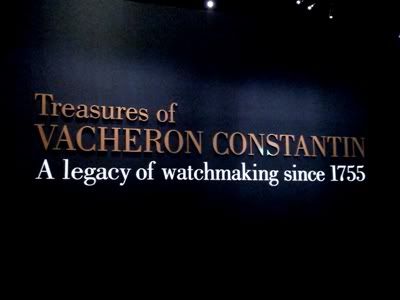 This Swiss watch owners include Napoleon Bonaparte, Pope Pius XI, the Duke of Windsor and Harry Truman.
This Swiss watch owners include Napoleon Bonaparte, Pope Pius XI, the Duke of Windsor and Harry Truman.
The exhibition explores the heritage of the oldest watch manufacturer. 180 timepieces were on display. The photos in this post were taken using my Samsung Galaxy S2, so the quality isn't top-notched. But at least it gives those who missed the exhibition, glimpses of the exquisite timepieces from Vacheron Constantin. The descriptions are mostly lifted from the exhibition itself.
 To start off, some background information about enamelling:
To start off, some background information about enamelling:
The art of enamelling was already much appreciated by the ancient Egyptians ca. 1500 BCE. Following a long history of this beautifying technique, watchmakers introduced enamelling to watches during the 17th century in Geneva, Switzerland.
The art of enamelling comprises several techniques: Champlevé (protruding enamel) cloisonné (enclosed enamel) and miniature painting. In champlevé, the pattern is engraved on a sheet of gold with the hollows filled with enamel. With the cloisonné technique, the enameller creates his own design by applying a thin gold wire to primary layer of enamelling and the cloisons (partitions) formed are then filled with enamel. Regardless of the technique used, the piece is fired several times - depending how many colours used - at about 800 degree Celsius. The colour is obtained by mixing glass and metal oxide according to traditional alchemist' formulas.
Extremely refined and difficult, the miniature-painting technique enables the artist to reproduce a great masterpiece with a depth and vividness of colour rivalling that of the original. The fine powders and pigments used in miniature paintings are combined with natural essential oils. Depending on the complexity of the design and the number of colours used, the enamel can require firing more than 20 times at about 800 degree Celsius.
If the enameller uses the Genevan technique, he will protect the painting once ready. In the final delicate stage he applies successive layers of translucent enamel (the fondant), firing the object between each layer. The translucent layers enhance the intensity and brightness of the colours and emphasise the subtlety and depth of work.
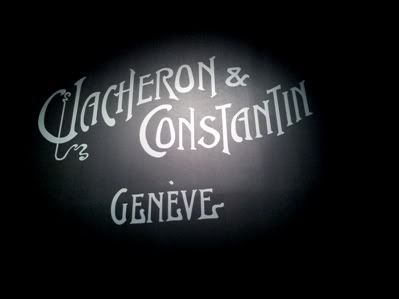 Vacheron Constantin's collection of antique enamelled watches is an illustration of wide variety of technique available and the sources of inspiration for past generations of enamellers, such as travel, nature and floral patterns, scenes, landscapes and miniature reporductions of the great masters.
Vacheron Constantin's collection of antique enamelled watches is an illustration of wide variety of technique available and the sources of inspiration for past generations of enamellers, such as travel, nature and floral patterns, scenes, landscapes and miniature reporductions of the great masters.
This is a scene from the workshop of Jean-Marc Vacheron.
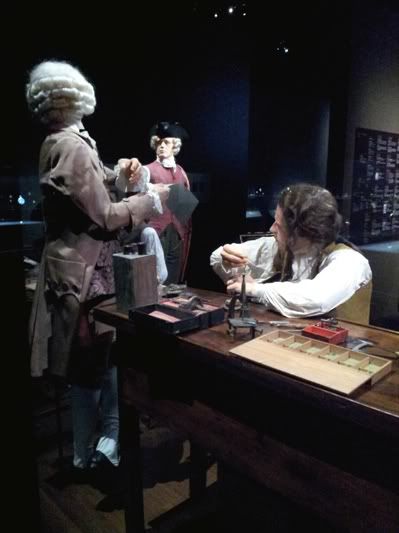
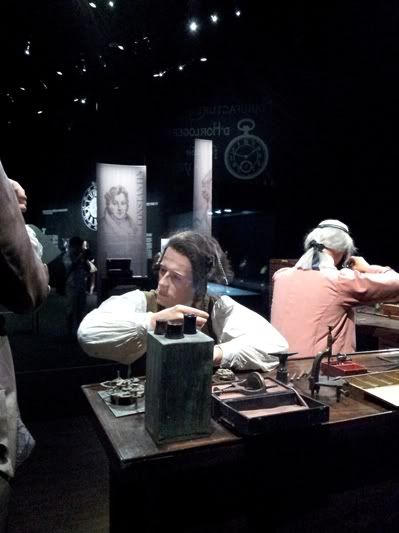 One of the extraordinary feat was the creation of the world's thinnest watch back then.
One of the extraordinary feat was the creation of the world's thinnest watch back then.
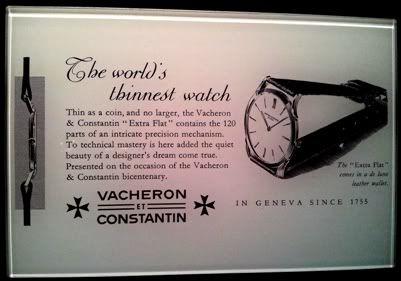 This is a 8 days desk clock made in 1905. Glit silver, agate, lacquer, 8/8-cut diamonds, Caliber RA 19" - 8 days, "Breguet" balance-spring, 17 jewels. This clock's champlevé lacquer case with line engraving and bead-set diamonds, was made by Verger Frères.
This is a 8 days desk clock made in 1905. Glit silver, agate, lacquer, 8/8-cut diamonds, Caliber RA 19" - 8 days, "Breguet" balance-spring, 17 jewels. This clock's champlevé lacquer case with line engraving and bead-set diamonds, was made by Verger Frères.
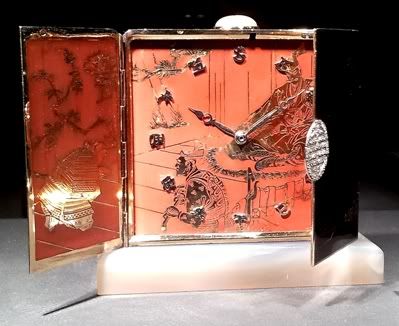 Another 8 days desk clock, made in 1926. Brass, white gold, lacquer, agate, lapis lazuli, turquoises, nephrite, opals, rose-cut diamonds, Caliber RA 19" - 8 days, lever escapement, "Breguet" balance-spring, 17 jewels. This clock's case was made by Verger Frères and embellished with bead-set diamonds.
Another 8 days desk clock, made in 1926. Brass, white gold, lacquer, agate, lapis lazuli, turquoises, nephrite, opals, rose-cut diamonds, Caliber RA 19" - 8 days, lever escapement, "Breguet" balance-spring, 17 jewels. This clock's case was made by Verger Frères and embellished with bead-set diamonds.
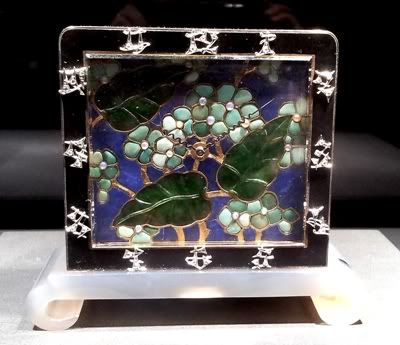 Lady's pendant watch, made in 1919. Platinum, brilliant-cut diamonds, rose-cut diamonds, leather rope, slivered dial, Caliber RA 5", lateral lever escapement, flat balance-spring, 15 jewels. This watch was special order for Wilhelm A. Bolin, a jeweller at the Russian and Swedish courts. It is embellished with bead-set diamonds and millegrain decoration.
Lady's pendant watch, made in 1919. Platinum, brilliant-cut diamonds, rose-cut diamonds, leather rope, slivered dial, Caliber RA 5", lateral lever escapement, flat balance-spring, 15 jewels. This watch was special order for Wilhelm A. Bolin, a jeweller at the Russian and Swedish courts. It is embellished with bead-set diamonds and millegrain decoration.
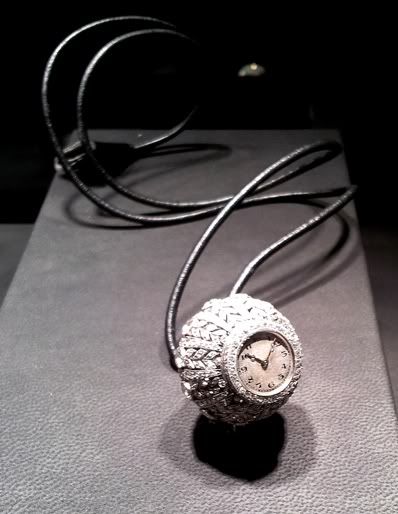 One of the highlights of this exhibition. This pocket-watch was made in 1923. Yellow gold, enamel, enamel dial, engraved movement, Caliber 17" medium, lever escapement, 18 jewels, hand-decorated. The back of the case is enameled with a miniature of the painting "Les Bergers D'Arcadie" by Nicolas Poussin; painted by Marie Goll, a leading 20th-century Genevan enamel miniaturist. The double back cover is engraved using the pounced ornament technique depicting a pastoral scene. The movement features line engraving of two angels.
One of the highlights of this exhibition. This pocket-watch was made in 1923. Yellow gold, enamel, enamel dial, engraved movement, Caliber 17" medium, lever escapement, 18 jewels, hand-decorated. The back of the case is enameled with a miniature of the painting "Les Bergers D'Arcadie" by Nicolas Poussin; painted by Marie Goll, a leading 20th-century Genevan enamel miniaturist. The double back cover is engraved using the pounced ornament technique depicting a pastoral scene. The movement features line engraving of two angels.
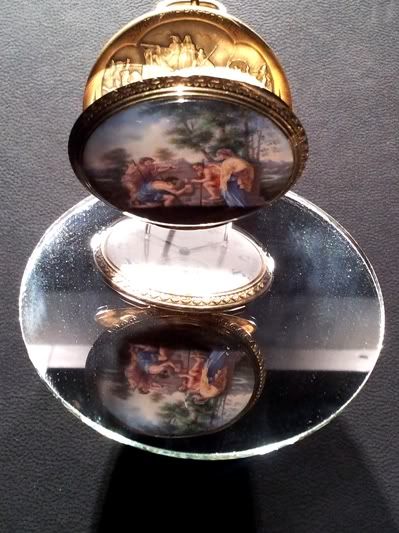 "Arms up" pocket-watch made in 1960. 18K yellow gold, white gold, pink gold, Caliber RA 17" 15/12 "arms up" display, lever escapement, flat balance-spring, 18 jewels. The silver dial of this watch represents shuttlecock players whose arms indicate the hours and minutes.
"Arms up" pocket-watch made in 1960. 18K yellow gold, white gold, pink gold, Caliber RA 17" 15/12 "arms up" display, lever escapement, flat balance-spring, 18 jewels. The silver dial of this watch represents shuttlecock players whose arms indicate the hours and minutes.
 More information can be found on Facebook and the official site.
More information can be found on Facebook and the official site.

The exhibition explores the heritage of the oldest watch manufacturer. 180 timepieces were on display. The photos in this post were taken using my Samsung Galaxy S2, so the quality isn't top-notched. But at least it gives those who missed the exhibition, glimpses of the exquisite timepieces from Vacheron Constantin. The descriptions are mostly lifted from the exhibition itself.

The art of enamelling was already much appreciated by the ancient Egyptians ca. 1500 BCE. Following a long history of this beautifying technique, watchmakers introduced enamelling to watches during the 17th century in Geneva, Switzerland.
The art of enamelling comprises several techniques: Champlevé (protruding enamel) cloisonné (enclosed enamel) and miniature painting. In champlevé, the pattern is engraved on a sheet of gold with the hollows filled with enamel. With the cloisonné technique, the enameller creates his own design by applying a thin gold wire to primary layer of enamelling and the cloisons (partitions) formed are then filled with enamel. Regardless of the technique used, the piece is fired several times - depending how many colours used - at about 800 degree Celsius. The colour is obtained by mixing glass and metal oxide according to traditional alchemist' formulas.
Extremely refined and difficult, the miniature-painting technique enables the artist to reproduce a great masterpiece with a depth and vividness of colour rivalling that of the original. The fine powders and pigments used in miniature paintings are combined with natural essential oils. Depending on the complexity of the design and the number of colours used, the enamel can require firing more than 20 times at about 800 degree Celsius.
If the enameller uses the Genevan technique, he will protect the painting once ready. In the final delicate stage he applies successive layers of translucent enamel (the fondant), firing the object between each layer. The translucent layers enhance the intensity and brightness of the colours and emphasise the subtlety and depth of work.

This is a scene from the workshop of Jean-Marc Vacheron.








Comments